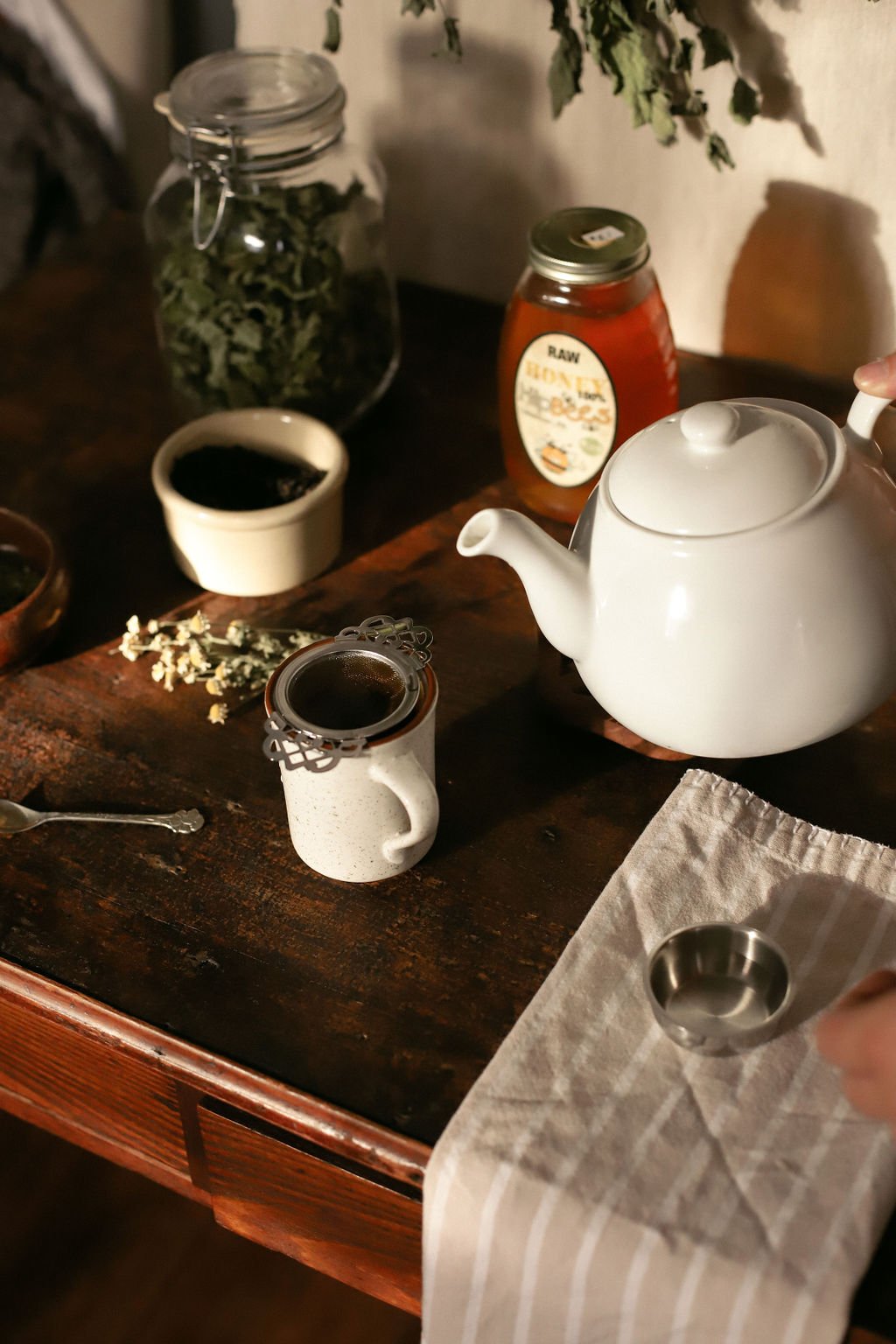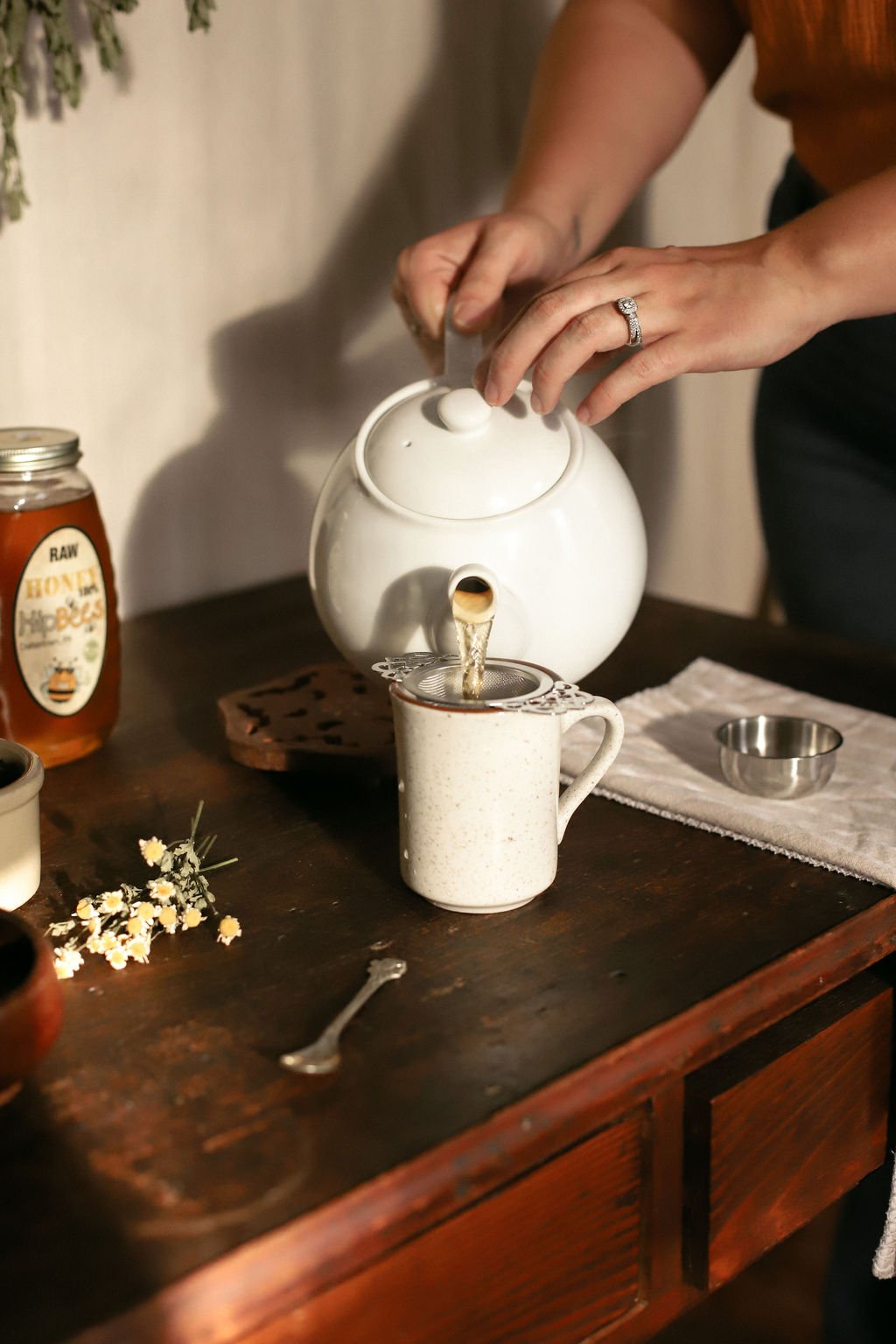An Introduction to Herbal Tea Blending
There is something about the ritual of making a cup of tea that transcends space and time. For thousands of years and all over the world, people have been combining leaves and hot water to create simple beverages that are deeply nourishing to both the body and soul. Many cultures have their own traditions surrounding tea making, some viewing it as a sacred art.
The health benefits of tea
Drinking tea has many health benefits beyond just hydration, from the antioxidants, vitamins and minerals found in the leaves of the tea plant, camellia sinensis, to the myriad of medicinal benefits that herbal teas can offer. Here’s an article from Penn Medicine for further reading: The Hidden Benefits of Tea
Why loose leaf tea?
Loose leaf tea is preferred by many tea connoisseurs for it’s superior freshness, quality and flavor and providing the ability to make your own blends. Compared to tea that comes pre-packaged in individual bags, which often contains tea that has been ground down into a dust, loose leaf tea contains whole or lightly ground leaves, which create a stronger, more consistent flavor. Brewing loose leaf tea also gives the dried leaves more room to expand, allowing a greater concentration of nutrients, including antioxidants, vitamins, minerals to infuse into the hot water.
Lastly, loose leaf tea is a more environmentally friendly alternative because many pre-packaged tea bags contain plastic, either in the material of the bag or in the adhesives used to keep the bag together. In addition to being non-recyclable and non-compostable and polluting the environment, these plastics can begin to break down in the hot water leaking plastic particles into the drink itself. Here’s an article from Country Living UK for further reading, Plastic-free tea bags: the brands that don’t contain plastic and the brands that still do.
Types of tea: Black, Green, White, Oolong
Most Black, Green and White teas come from the same tea plant, camellia sinensis which is native to East Asia. Depending on where the tea is grown, it may have a distinctive flavor or be called a different name, for example; Ceylon tea is Black tea from the camellia sinensis plant grown in Sri Lanka. Assam tea is a black tea from a varietal named camellia sinesis assamica grown in India.
Tea leaves are harvested and allowed to oxidize, or dry and darken, for different lengths of time. Black tea is allowed to oxidize for the longest (90-100% oxidation), which creates a deeper color, stronger flavor and aroma. Green and White tea leaves are typically unoxidized or very minimally oxidized (0-10% oxidation), which helps them retain a light, fresh flavor profile. Oolong teas fall in the wide spectrum Black and Green tea preparations (10-80% oxidation), with lighter Oolongs tasting more like a Green tea and darker Oolongs tasting similar to Black tea, though with a bit more subtle flavor.
Longer oxidation times also increase the natural caffeine content of the tea leaves. Black tea has the highest concentration of caffeine, at about 47mg per cup. One cup of Green tea typically contains 28mg.
Types of tea: Herbal
Herbal teas are made with the fresh or dried leaves, flowers, fruit, seeds or roots of an edible plant. Most herbal teas are naturally caffeine-free, which makes them a popular choice for those monitoring their caffeine intake. Herbal teas make great natural remedies for minor ailments and discomforts. You are likely familiar with the concept of sipping chamomile tea to help you fall asleep at night. There really is an herb out there for everything! I’m a student of herbalism, not a teacher, but if you are looking to learn more about plant medicine here are a few resources I recommend that focus on ethical, sustainable & bioregional herbalism: Northern Appalachia School, Rowan + Sage, Farai Herrald.
Here are some commonly used tea herbs, flowers & spices:
Herbal:
Lemon Balm
Lemongrass
Peppermint
Spearmint
Raspberry Leaf
Tulsi/Holy Basil
Spruce/Fir
Bee Balm
Anise Hyssop
Floral:
Rose
Lavender
Chamomile
Calendula
Hibiscus
Jasmine
Elderflower
Dandelion
Butterfly pea flower
Passionflower
Spices:
Cinnamon
Ginger
Clove
Peppercorn
Cardamom
Allspice
Anise
Saffron
Vanilla
Dried Fruit:
Coconut
Lemon peel
Orange peel
Bergamot
Apple
Peach
Raspberry
The ratio of loose leaf tea to water
1 teaspoon of dried tea per one cup of water
2 cup (.5 L ) teapot = 2 teaspoons of tea
4 cup (1L) teapot = 4 teaspoons of tea
6 cup (1.5L) teapot = 6 teaspoons of tea
Making your own loose leaf tea blends
Choose your base tea flavor (70%): The above five types (Black, Green, White, Oolong and Herbal) are the most common base ingredients for loose leaf tea blends. The flavor of the base you choose will be the anchor for the rest of the blend. When making your own tea flavor pairings, here are some things to keep in mind:
Black tea as a base - strong, earthy, full-bodied, pairs well with bold and sweet flavors, contains the most caffeine.
White tea as a base - more subtle, silky, herbal, lighter-bodied, pairs well with mild and fruity flavors, and contains the least amount of caffeine.
Green tea as base - light-bodied, bittersweet, grassy, vegetal, sometimes nutty, pairs well with fresh and citrus flavors, contains a minimal amount of caffeine.
Oolong tea as a base - versatile, ranges from light to full bodied, pairs well with citrus and floral flavors, contains a moderate amount of caffeine.
Herbal tea as a base – widest variety of flavors, choose either calming or invigorating herbs with a pleasant overall flavor (bitter or spicy flavors are best as supportive or catalyst herbs), naturally caffeine-free.
Choose your complementary flavors (30%): Whether you’ve chosen a camellia sinensis tea base or an herbal one, the next portion of your blend should be 1-3 herbs that complement your chosen base and each other. Full-bodied base teas, like black and some oolong, blend well with stronger, bolder flavors whereas lighter-bodied teas, like white or green, are best paired with milder, more delicate flavors. For a well-balanced blend, it’s nice to combine herbal, floral, spice and fruit flavors. You can play around with the proportions here to control which flavors you want to be more forward and which you want to be more subtle within your blend.
Choose your accent flavors (10%): The final component of a good tea blend is the catalyst or accent flavors. This a good place to include warming spices (like cinnamon, clove, ginger or peppercorn), bright citrus or fruity flavors to add a pop of acidity, or something very aromatic or floral like spruce tips or lavender.
How to make loose leaf tea in a teapot
There are a few ways to do this. You can use an infuser if you are making one pot for yourself to sip on over the course of several hours. (A tea cozy is a great idea for keeping the tea in your teapot warm!) If you are serving immediately, I like using an external strainer that sits over the mouth of the cup.
Boil fresh water in a kettle, stovetop or electric
Pour just enough boiling water in the bottom of your teapot to warm it, swirl it around and then pour it out.
Add your tea leaves to the bottom of the pot or into your infuser. You need 1 teaspoon of dried tea per cup of water.
Pour boiling water over the leaves, and allow to brew for 3-5 minutes for black tea, and 5 minutes or more for herbal teas.
Once the tea is done brewing, pour into cups through a tea strainer. If using an infuser, you can remove it at this point.
Add milk and honey, if desired.










